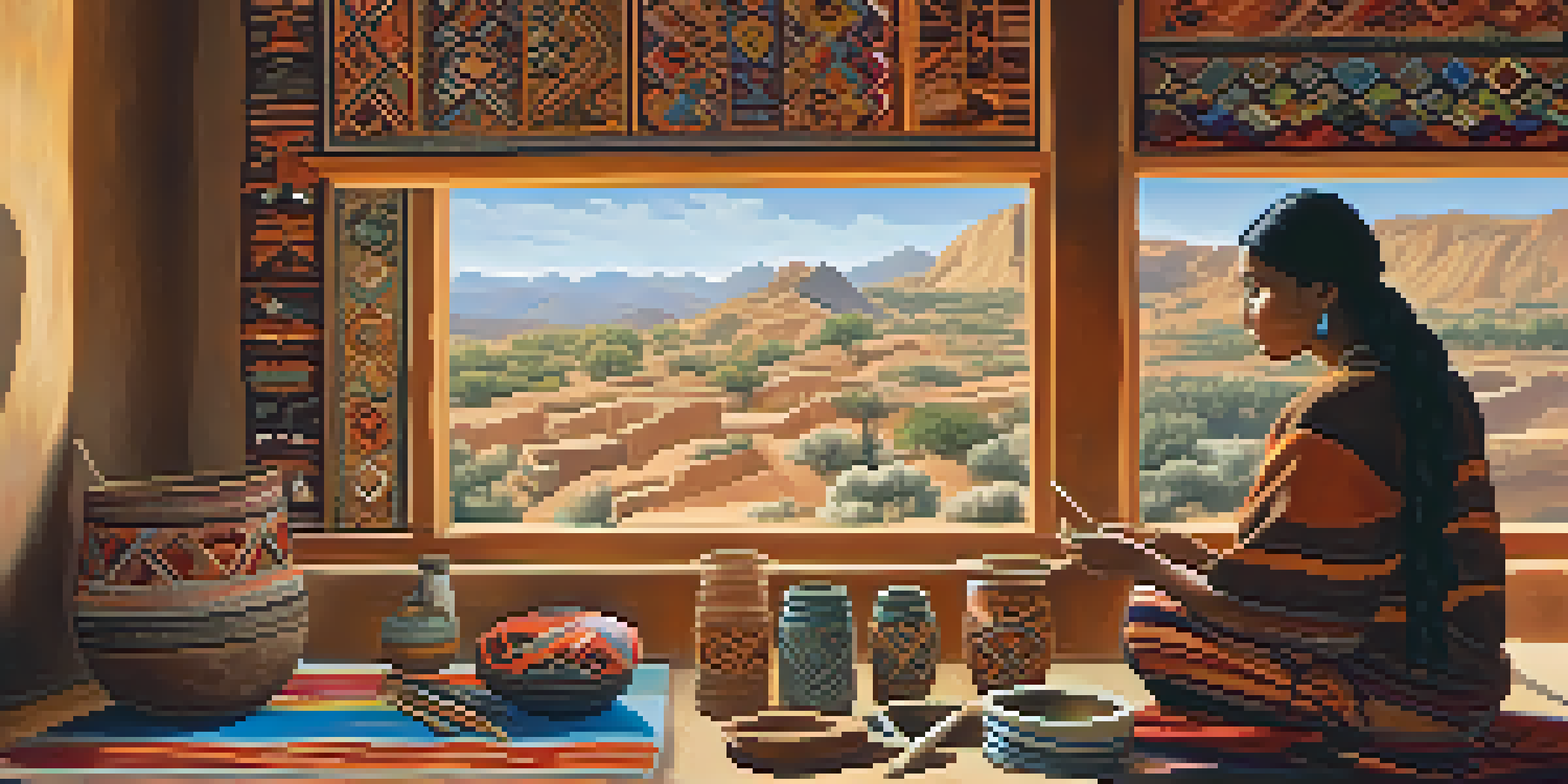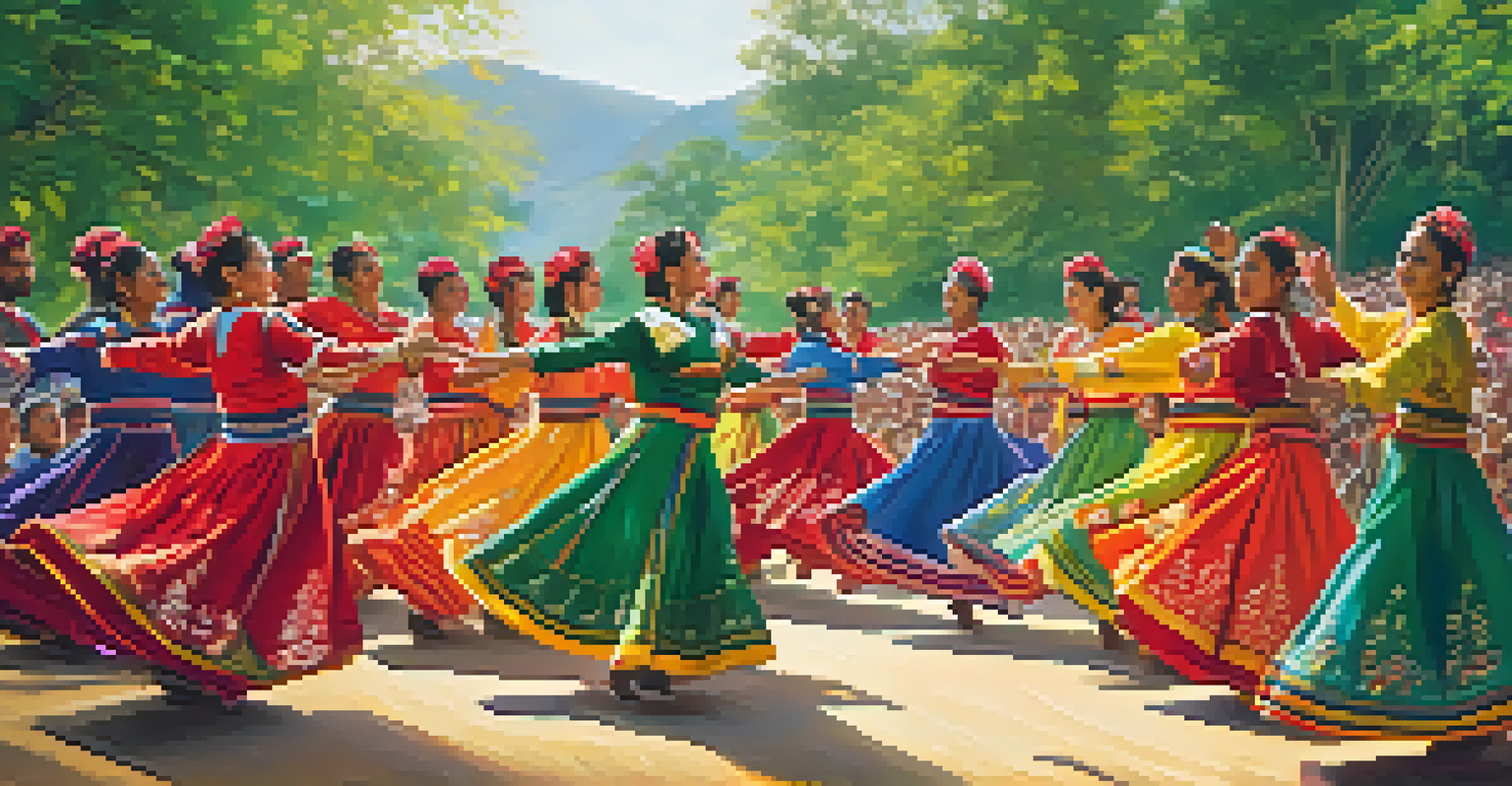Cultural Heritage and Its Influence on Artistic Expression

Understanding Cultural Heritage and Its Significance
Cultural heritage refers to the legacy of physical artifacts and intangible attributes inherited from past generations. It encompasses traditions, languages, and monuments that define a group’s identity. This heritage is essential as it connects communities, fosters pride, and provides a sense of belonging.
Cultural heritage is the foundation of our identity and a source of inspiration for artistic expression.
Artistic expression often draws from this rich tapestry of cultural heritage. Artists channel their experiences, beliefs, and values into their work, reflecting the history and traditions that shape their perspectives. This interplay creates a dialogue between the past and present, making art a living testament to cultural identity.
By understanding cultural heritage, we can appreciate the depth and meaning behind various art forms. Whether it's a traditional dance, a painting, or a piece of music, these expressions serve as a bridge, linking us to the values and stories of those who came before us.
Art as a Reflection of Cultural Values
Art is not created in a vacuum; it is deeply influenced by the cultural values of the artist's community. For instance, indigenous art forms often incorporate symbols and stories that reflect the beliefs and practices of that culture. This connection ensures that the artwork resonates with the community's identity and values.

When artists tap into cultural values, they create works that speak to shared experiences and collective memories. This can be seen in the vibrant textiles of African cultures or the intricate carvings from Asian traditions, each piece telling a story that embodies the essence of its culture. These artworks serve as visual narratives that honor and preserve cultural legacies.
Cultural Heritage Shapes Identity
Cultural heritage connects communities and fosters a sense of belonging through shared traditions and values.
Moreover, as cultures evolve, so do their artistic expressions. Contemporary artists may reinterpret traditional motifs, blending them with modern techniques to keep their heritage alive while making it relevant for today’s audience. This evolution highlights the dynamic nature of cultural heritage in art.
The Role of Folklore in Artistic Expression
Folklore is a treasure trove of stories, myths, and legends passed down through generations, and it plays a crucial role in shaping artistic expression. Artists often draw inspiration from folklore, using it as a source of themes, characters, and narratives. This connection not only enriches the artistic process but also helps preserve these stories for future generations.
Art is the most beautiful of all lies; it is the myth of our cultural heritage brought to life.
For example, many traditional performances, such as ballet, opera, and theater, incorporate folklore elements to convey moral lessons or cultural values. These performances become a platform for sharing age-old stories, allowing audiences to connect with their heritage through the arts. The enchanting tales of fairies, heroes, and gods bring cultural identity to life in compelling ways.
Incorporating folklore into art also allows for a playful exploration of cultural identity. Artists can reinterpret these tales, adding modern twists that resonate with contemporary audiences while respecting the original narratives. This blend of old and new keeps folklore alive and relevant, showcasing the adaptability of cultural expression.
Cultural Exchange and Its Artistic Impact
Cultural exchange is a powerful force in the world of art, allowing for the blending of different traditions and ideas. As artists interact with diverse cultures, they often absorb influences that inspire new styles and techniques. This cross-pollination can lead to the emergence of innovative art forms that reflect a fusion of cultural heritages.
Take the example of jazz music, which emerged from a blend of African American musical traditions and European influences. Jazz not only represents a unique form of artistic expression but also serves as a historical narrative of cultural exchange. The genre’s evolution showcases how different cultures can enrich one another through collaboration and creativity.
Art Reflects Cultural Values
Art serves as a powerful medium that communicates and preserves the beliefs and practices of a community.
As globalization continues to connect people across the globe, artists have unprecedented access to a variety of cultural influences. This interconnectedness can result in works that celebrate diversity and inclusivity, ultimately enriching the global artistic landscape. The art created in this context often tells stories of shared humanity, breaking down barriers and fostering understanding.
Art as a Tool for Cultural Preservation
Art plays a vital role in preserving cultural heritage for future generations. Through various forms—be it painting, sculpture, or performance—artists document and celebrate their cultural practices, ensuring they are not forgotten. This preservation is particularly important in a world where globalization can sometimes overshadow local traditions.
For instance, indigenous artists often create works that reflect their community's values, stories, and struggles. By doing so, they not only honor their heritage but also educate others about their culture. This act of creation becomes a powerful statement of identity and resilience, showcasing the importance of cultural preservation in the face of change.
Moreover, art can serve as a medium for activism, raising awareness about cultural issues and advocating for the protection of heritage sites and practices. Through exhibitions, performances, and community projects, artists can mobilize support for cultural preservation, demonstrating the significant impact art can have on societal values and priorities.
The Influence of Technology on Artistic Expression
In the digital age, technology is transforming artistic expression in unprecedented ways. Artists now have access to tools and platforms that enable them to explore and experiment with their cultural heritage like never before. From digital art to virtual reality installations, technology allows for innovative interpretations of traditional art forms.
For example, augmented reality can bring ancient artifacts to life, allowing viewers to interact with them in a whole new way. This technological integration not only enhances the experience of cultural heritage but also makes it accessible to a broader audience. As artists embrace these tools, they can share their cultural narratives with the world, fostering appreciation and understanding.
Technology Transforms Artistic Expression
In the digital age, technology enables innovative interpretations of cultural heritage, enhancing accessibility and engagement.
However, while technology offers exciting opportunities, it also raises questions about authenticity and cultural appropriation. Artists must navigate these challenges thoughtfully, ensuring they honor the traditions they draw from while also embracing new methods of expression. The balance between innovation and respect for cultural heritage is essential in this evolving artistic landscape.
The Future of Cultural Heritage in Artistic Expression
As we look to the future, the integration of cultural heritage in artistic expression will continue to evolve. New generations of artists are emerging, eager to explore their roots while pushing the boundaries of creativity. This dynamic interplay between tradition and innovation promises to enrich the arts landscape and keep cultural narratives alive.
Collaborative projects that bring together artists from different backgrounds will likely become more prevalent. These collaborations can lead to the creation of hybrid art forms that reflect a myriad of cultural influences, celebrating diversity and fostering understanding. The future of art will be a tapestry woven from the threads of various cultural legacies.

Ultimately, the ongoing dialogue between cultural heritage and artistic expression will shape our understanding of identity, community, and creativity. As we embrace the richness of our diverse backgrounds, we can ensure that the stories, values, and traditions that define us continue to inspire and resonate in the art of tomorrow.